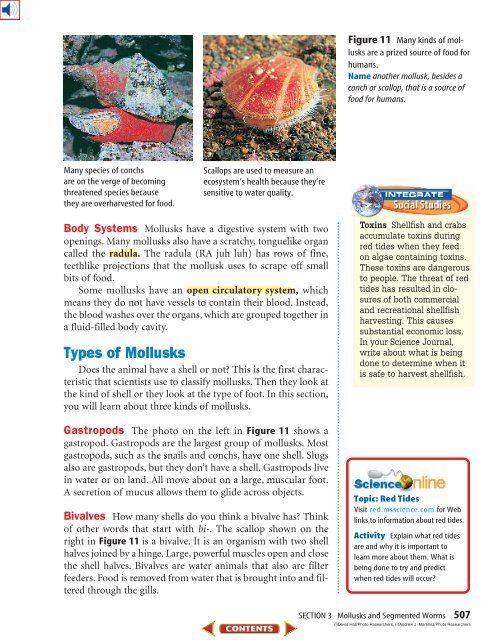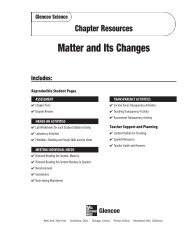Chapter 17: Invertebrate Animals
Chapter 17: Invertebrate Animals
Chapter 17: Invertebrate Animals
Create successful ePaper yourself
Turn your PDF publications into a flip-book with our unique Google optimized e-Paper software.
Figure 11 Many kinds of mollusks<br />
are a prized source of food for<br />
humans.<br />
Name another mollusk, besides a<br />
conch or scallop, that is a source of<br />
food for humans.<br />
Many species of conchs<br />
are on the verge of becoming<br />
threatened species because<br />
they are overharvested for food.<br />
Scallops are used to measure an<br />
ecosystem’s health because they’re<br />
sensitive to water quality.<br />
Body Systems Mollusks have a digestive system with two<br />
openings. Many mollusks also have a scratchy, tonguelike organ<br />
called the radula. The radula (RA juh luh) has rows of fine,<br />
teethlike projections that the mollusk uses to scrape off small<br />
bits of food.<br />
Some mollusks have an open circulatory system, which<br />
means they do not have vessels to contain their blood. Instead,<br />
the blood washes over the organs, which are grouped together in<br />
a fluid-filled body cavity.<br />
Types of Mollusks<br />
Does the animal have a shell or not This is the first characteristic<br />
that scientists use to classify mollusks. Then they look at<br />
the kind of shell or they look at the type of foot. In this section,<br />
you will learn about three kinds of mollusks.<br />
Gastropods The photo on the left in Figure 11 shows a<br />
gastropod. Gastropods are the largest group of mollusks. Most<br />
gastropods, such as the snails and conchs, have one shell. Slugs<br />
also are gastropods, but they don’t have a shell. Gastropods live<br />
in water or on land. All move about on a large, muscular foot.<br />
A secretion of mucus allows them to glide across objects.<br />
Bivalves How many shells do you think a bivalve has Think<br />
of other words that start with bi-. The scallop shown on the<br />
right in Figure 11 is a bivalve. It is an organism with two shell<br />
halves joined by a hinge. Large, powerful muscles open and close<br />
the shell halves. Bivalves are water animals that also are filter<br />
feeders. Food is removed from water that is brought into and filtered<br />
through the gills.<br />
Toxins Shellfish and crabs<br />
accumulate toxins during<br />
red tides when they feed<br />
on algae containing toxins.<br />
These toxins are dangerous<br />
to people. The threat of red<br />
tides has resulted in closures<br />
of both commercial<br />
and recreational shellfish<br />
harvesting. This causes<br />
substantial economic loss.<br />
In your Science Journal,<br />
write about what is being<br />
done to determine when it<br />
is safe to harvest shellfish.<br />
Topic: Red Tides<br />
Visit red.msscience.com for Web<br />
links to information about red tides.<br />
Activity Explain what red tides<br />
are and why it is important to<br />
learn more about them. What is<br />
being done to try and predict<br />
when red tides will occur<br />
SECTION 3 Mollusks and Segmented Worms 507<br />
(l)David Hall/Photo Researchers, (r)Andrew J. Martinez/Photo Researchers














